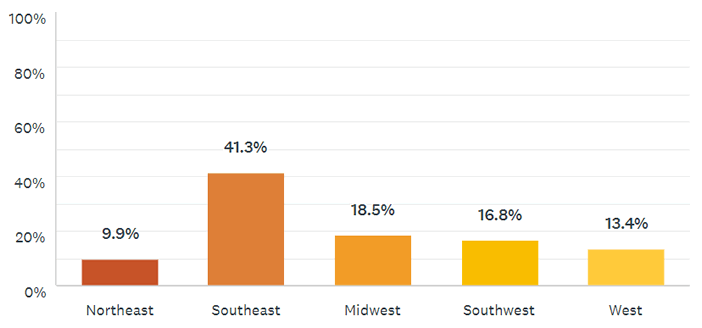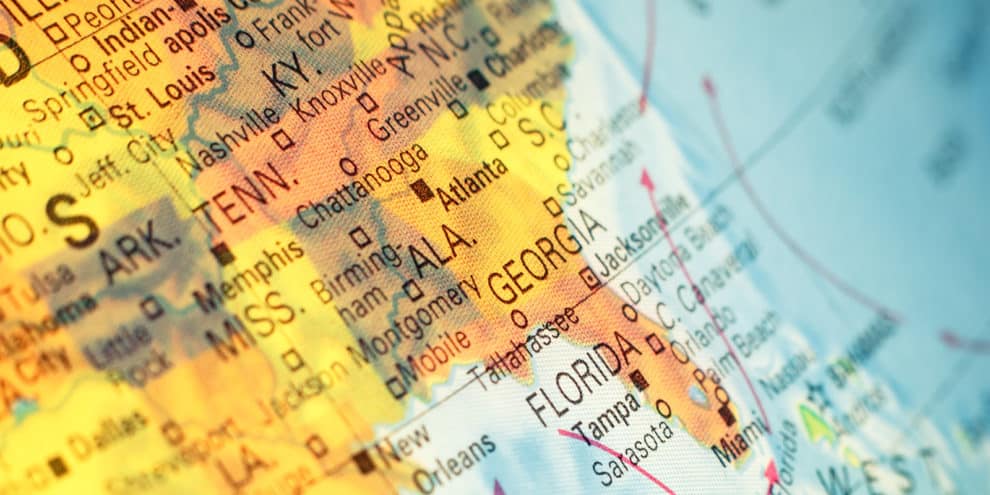Last month, the LANDTHINK Pulse posed the following question to our audience: Within the next year, which region of the United States do you think will be the “hot spot” for investing in land?
August Pulse Sponsored By
LANDTHINK received a tremendous number of responses from subscribers, fans, followers and land industry professionals all across the country, with our informal online survey revealing that 41.3% of respondents believe that the Southeast region of the U.S will be ripe for land investing within the next year.
It’s inarguably true that the land real estate market is firing on all cylinders under the Trump Administration and a Republican-led congress. President Trump’s high-performing economy is the rising tide that is lifting all boats. The U.S. economy had a blockbuster second quarter with gross domestic product surging, strong job growth, increased income, spending power, and consumer confidence- all factors that lead to vigorous land investment. It appears 2018 is shaping up to be even better than 2017; most people fundamentally believe that land is a good investment and are choosing to make this asset a critical part of their portfolio.
Ben Alder, of SVN Land Group, says that because of the adaptive nature of land, it is not subject to the vast array of economic forces both domestically and foreign creating volatility in many other asset classes. In his LANDTHINK article Making the Financial Argument for Land Investing, Alder points out that “Land is a tangible asset with transitional qualities, and unlike many investments it cannot be downgraded to zero as can many paper assets. It will not simply evaporate into ‘the market’, and even after the worst day on the land market, you can still go take a walk on it.”
So, why is the Southeast believed to be the next hotbed for land investing? Well, land investors know the drill. When it comes to choosing a location, investors look to spend their money in an area that’s expected to experience expanding demand and growth in the years ahead. But most land buyers buy for personal enjoyment, and a good financial return is a secondary bonus.
Research shows that the rural population of the U.S. is growing, as working remotely has seen a huge surge in popularity and more people are retiring and moving away from the city. They are gravitating to areas like the Southeast, that can provide a range of year-round outdoor activities, a warmer climate, and a lower cost of living.
LANDTHINK often collaborates with a wide network of land industry experts, including our contributors, who help us analyze and examine the current state of the real estate land market. We asked some of the top land experts for their insight as to why the results of last month’s Pulse question indicated that the Southeast would be trending within the next year.
Here’s what they had to say:
Chris Miller, ALC, American Forest Management (NC): “I think a major reason the South is considered a hot spot is the sustained population growth. Ten of the 15 fastest growing U.S. cities in 2016 were located in the south and those trends continue. This population growth is coupled with acreage available within a 1-2 hour drive of highly desirable places to live and work. This proximity to where people want to live and work creates strong demand for a tangible investment they can easily visit and enjoy.”
Pat Porter, Broker for RecLand Realty (LA): “The Southeast region of the U.S. has an inherent mix of timberland coupled with recreation. This provides an income component to the recreational tracts that may be missing in other regions. For instance, we sell superior deer & turkey hunting tracts in Missouri, but the timber component is typically weaker – at least as a shorter term rotational timber investment. The Southeast provides a nice balance of enjoyment and financial returns. While there are many characteristics that make a good timberland investment tract, being in an area that has mills nearby that purchase the type of forest product being grown makes it attractive for investment return.”
Coming in second (18.5%) among our audience as the next hot spot for land investment was the Midwest, where agriculture prices and land values are holding up well. Low commodity prices and escalating trade wars have undoubtedly hampered farmers’ bottom lines, but land investors focus on farmland as a longer-term investment, and may consider the trade tensions to be short term. Given rising global food demand and the scarcity of farmland, savvy investors know that farms are tried-and-true money makers and believe in their long-term resiliency.
Ben Alder’s assessment in his LANDTHINK article that “Farmland and timberland is adaptive and any asset which can absorb a changing economic landscape is coveted and valuable” further validates the Southeast and Midwest as “hot spots” for investors, two regions known for their quality timberland and productive farmland.
The LANDTHINK audience certainly had a strong opinion on which region of the U.S. would be ripe for land investment. The results showed some mixed views, but the majority of our audience (41.3%) believed the Southeast was emerging as the next hot spot for land investors, followed by 18.5% who said the Midwest would attract land investors looking for the next opportunity. Only 16.8% of our audience indicated the Southwest, and only 13.4% believed land in the West would be highly sought-after by land investors. A scant 9.9% thought the Northeast region would be an attractive spot for land investors.
Here’s how the results panned out:

We were pleased that so many people chimed in on this question, and we thank everyone who answered the Pulse and shared it on social media with friends and connections in the land industry. LANDTHINK would like to extend a big thank thank you to United Country Real Estate for sponsoring the August Pulse and for coming up with a very interesting question to pose to our audience.
United Country Real Estate is the leading, fully integrated network of conventional and auction real estate professionals. The company has been an innovator in ranch, farm, recreational, lifestyle and country real estate marketing since 1925. United Country supports nearly 500 offices and 4,000 real estate professionals nationally, with a unique, comprehensive and proven marketing program.
Become a Pulse sponsor! It’s a great way to ensure your brokerage is the first one buyers and sellers call when they have a need to buy or sell property. You’ll get insane exposure on Social + Email + Web. That’s 500,000+ monthly eyes on you! Once you have it, you won’t want to give it up! Pulse sponsorships are offered on a first come first serve basis and are subject to certain limitations. We’ve already secured sponsors for October and November, but if your business would be interested in sponsoring the December Pulse, please contact us soon.
Do you have a suggestion for next month’s Pulse question? Submit your question and we might choose yours!
We want to know what you think about our September Pulse question, chosen and sponsored by Southeastern Land Group: If you were to buy a recreational property for your personal use, would you prefer a fixer-upper that can be customized or a turnkey property that’s ready to use? Answer now.
This content may not be used or reproduced in any manner whatsoever, in part or in whole, without written permission of LANDTHINK. Use of this content without permission is a violation of federal copyright law. The articles, posts, comments, opinions and information provided by LANDTHINK are for informational and research purposes only and DOES NOT substitute or coincide with the advice of an attorney, accountant, real estate broker or any other licensed real estate professional. LANDTHINK strongly advises visitors and readers to seek their own professional guidance and advice related to buying, investing in or selling real estate.











The South is booming in jobs and new residents. The recent hurricanes in the area has increased the demand for contractors and tradesmen. Both baby boomers and millenials are looking for single family housing. Both domestic and international companies are investing in facilities in the south due to the cost of living. All these factors make the south a great place to invest.